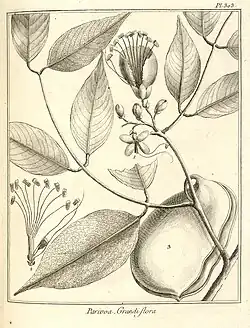Eperua grandiflora
| Eperua grandiflora | |
|---|---|

| |
| Drawing of the leaves, flowers and seedpods | |
| Scientific classification | |
| Kingdom: | Plantae |
| Clade: | Tracheophytes |
| Clade: | Angiosperms |
| Clade: | Eudicots |
| Clade: | Rosids |
| Order: | Fabales |
| Family: | Fabaceae |
| Genus: | Eperua |
| Species: | E. grandiflora
|
| Binomial name | |
| Eperua grandiflora | |
| Synonyms[1] | |
| |
Eperua grandiflora (Arawak: Yoboko, Itoeri Walaba, Guyanese Creole: Ituri Wallaba, Yokobo Wallaba)[2] is a species of flowering plant in the family Fabaceae, native to northern South America.[1][3] This evergreen tree is used both for construction and medicinal purposes. Its inner bark is decoted as a traditional remedy for toothache.[2] This tree relies on gravity to disperse its seeds.[4]
References
- ^ a b "Eperua grandiflora Aubl". Plants of the World Online. Royal Botanic Gardens, Kew. Retrieved 30 April 2023.
- ^ a b Medicinal Plants of the Guianas (Guyana, Surinam, French Guiana).https://naturalhistory.si.edu/sites/default/files/media/file/medicinalplantsmaster1.pdf
- ^ "Eperua grandiflora (Aubl.) Baill. | Plants of the World Online | Kew Science". Plants of the World Online. Retrieved 2023-04-30.
- ^ Forget, Pierre-Michel (June 1992). "Regeneration Ecology of Eperua grandiflora (Caesalpiniaceae), a Large-Seeded Tree in French Guiana". Biotropica. 24 (2): 146–156. Bibcode:1992Biotr..24..146F. doi:10.2307/2388668. ISSN 0006-3606. JSTOR 2388668.